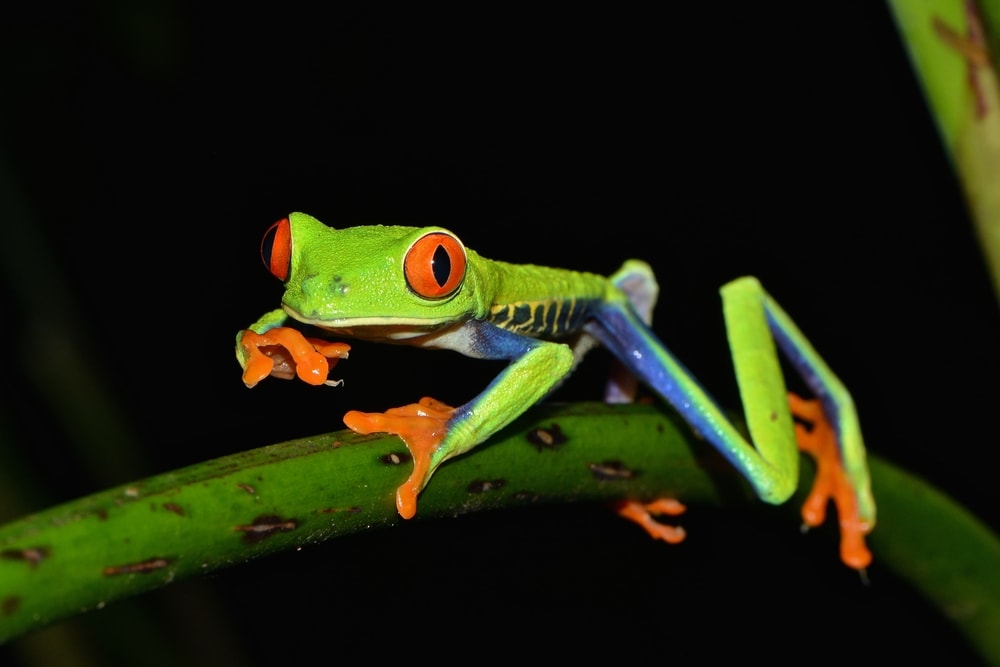Do Frogs Have Opposable Thumbs? Vet-Verified Facts & Anatomy
Updated on

Having opposable thumbs means you can touch the tips of all your fingertips with your thumb by flexing and rotating them. Can you imagine trying to write, type, open a jar, or simply hold an object without opposable thumbs? Humans are lucky enough to have this anatomical feature, but humans are not the only species that have them. When you think of other species with opposable thumbs, you normally think of apes, koala bears, pandas, and chameleons, but what about frogs? Do frogs have opposable thumbs?
There are over 6,000 known species of frogs, and perhaps surprisingly, some do have opposable thumbs. Most of the frogs with opposable thumbs are in the Phyllomedusa genus, including the Waxy Monkey Tree Frog, Black-eyed Monkey Frog, Tarsier Leaf Frog, and the Burmeister’s Leaf Frog. Certain frogs in other genera also have opposable thumbs, such as the Red-Eyed Tree Frog.
Let’s take a closer look at these fascinating amphibians.
The 5 Frogs With Opposable Thumbs
1. Waxy Monkey Tree Frog (Phyllomedusa sauvagii)
The Waxy Monkey Tree Frog is an adorable amphibian that can tolerate a wide range of temperatures, from 20°C to 40°C (68°F to 104°F). However, they are likely most comfortable in temperatures ranging from 20°C to 26°C (68°F to 79°F). They have glands located on the neck that secrete wax, which they rub themselves down with. They make sure every inch of skin is protected with the waxy layer, and they are able to do this with the help of their opposable thumbs. Their opposable thumbs also help them climb trees, hence the name. Despite their tolerance for high temperatures, they are nocturnal and do not appreciate sunlight.
These frogs are relatively small, ranging from around 7 cm to 9.5 cm (2.7–3.7 inches), and females are larger than males. Of all the frogs that possess an opposable thumb, this is the only species that is most commonly kept as a pet.

Where Can You Find the Waxy Monkey Tree Frog?
These frogs can be found in South America and are native to Gran Chaco. This semi-arid lowland forest spans eastern Bolivia, northern Paraguay, northern Argentina, and some parts of Brazil. They don’t hop around much, but rather love to hang out in trees and sleep most of the day. They are nocturnal and spend their evenings hunting insects to eat.
2. Black-Eyed Monkey Frog (Phyllomedusa camba)
The Black-Eyed Monkey Frog has unusually large irises and is distinguishable by their leafy-green coloration. Despite having opposable thumbs, their ability to climb trees is primarily attributed to the presence of specialized discs on their toes. These act as suction cups, which the frog uses to climb trees and find prey. They are believed to play an important role in controlling diseases, as they eat potentially disease-carrying insects as part of their natural diet.

Where Can You Find the Black-Eyed Monkey Frog?
You can find these bright green frogs in the southwestern Amazon Basin, from western Brazil to eastern Bolivia and down to southeastern Peru.
3. Tarsier Leaf Frog (Phyllomedusa tarsius)
The Tarsier Leaf Frog, like others in the genus, has green as their primary color. They sometimes have toes that are brown or white. Their color is further accentuated by their white and orange belly, which leads to a white throat. Their eyes are a spectacular mixture of orange, red, and black.
Like most frogs, the adult males of this species are smaller in size than the females. While the females can exceed 4 inches in snout-to-vent length, the males cap out at around 3.5 inches.

Where Can You Find the Tarsier Leaf Frog?
You can find this frog in Columbia, Brazil, Venezuela, Ecuador, Peru, and possibly Bolivia and Guyana. Its natural habitats are tropical and subtropical moist lowland forests, tropical and subtropical swamps, freshwater marshes, and degraded former forests. They, too, are an endangered species due to habitat loss.
4. Burmeister’s Leaf Frog (Phyllomedusa burmeisteri)
This species of frog, also known as the Common Walking Leaf Frog, is yet another species within the Phyllomedusa family with opposable thumbs. They are green in color with a yellow underside and circular patches of yellow/orange and black on the sides. Unfortunately, this species is sought after due to the waxy secretion that they produce, which many believe has medicinal uses. As a result, this species is susceptible to biopiracy and illegal trade.

Where Can You Find the Burmeister’s Leaf Frog?
This frog is native to the Atlantic Forest biome in Brazil.
5. Red-Eyed Tree Frog (Agalychnis callidryas)
These frogs are perhaps best known for their bright coloration. They possess a vibrant green body and striking blue and yellow stripes on their sides. Their underside is white, and their feet are bright red and orange. A final spark of coloration is attributed to their eyes, which are bright red in color—a trait that earns this species their name.
It is believed that their eyes are a defense mechanism of sorts. When this frog is threatened, they flash these eyes at their perceived threat, which may startle would-be predators, giving them an opportunity to escape.
Like many other frogs, they’re nocturnal and do most of their hunting for insects under the cover of darkness.

Where Can You Find the Tiger-Legged Monkey Frog?
These frogs are native to the forests of Central and South America.
Conclusion
Although opposable thumbs are a rarity in the animal kingdom, a selection of frog species does possess this feature. It is believed that their thumbs help them with locomotion or applying their natural secretions all over their body.
Read Also:
Featured Image Credit: G.J. Verspui, Shutterstock











